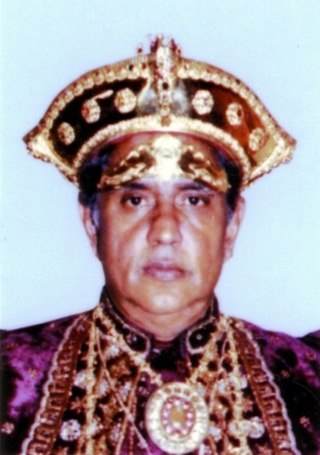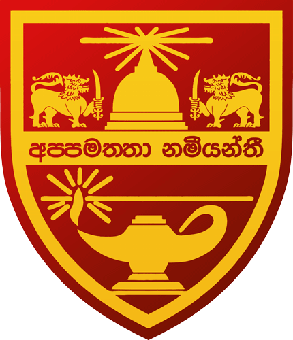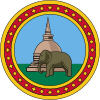
Anuradhapura is a major city located in the north central plain of Sri Lanka. It is the capital city of North Central Province and the capital of Anuradhapura District. The city lies 205 kilometers (127 mi) north of the current capital of Colombo in the North Central Province, on the banks of the historic Malwathu Oya. The city is now a World Heritage Site famous for its well-preserved ruins of the ancient Sinhalese civilisation.

The flag of Sri Lanka, also called the Sinha Flag or Lion Flag, consists of a golden lion holding a kastane sword in its right fore-paw in a maroon background with four gold bo leaves, one in each corner. This is bordered by gold, and to its left are two vertical stripes of equal size in teal and orange, with the orange stripe closest to the lion. The lion and the maroon background represent the Sinhalese, while the saffron border and four bo leaves represent the concepts of meththa, karuṇā, muditā and upecka respectively. The stripes represent the country's two largest minorities, with the orange representing the Tamils living in Sri Lanka – both the Sri Lankan Tamils and the Indian Tamils of Sri Lanka – and the green stripe representing the Sri Lankan Moors. The golden yellow border represents the other minority communities of the country.

Kegalle is a large town in Sabaragamuwa Province of Sri Lanka. It is located on the Colombo–Kandy road, approximately 78 km (48 mi) from Colombo, 40 km (25 mi) from Kandy, 32 km (20 mi) from Kurunegala and 46 km (29 mi) from Avissavella. It is the main town in the Kegalle District, which is one of two districts which comprise Sabaragamuwa Province. The town is governed by an Urban Council.
Moratuwa is a large municipality in Sri Lanka, on the southwestern coast of Sri Lanka, near Dehiwala-Mount Lavinia. It is situated on the Galle–Colombo main highway, 18 km (11 mi) south of the centre of Colombo. Moratuwa is surrounded on three sides by water, except in the north of the city, by the Indian Ocean on the west, the Lake Bolgoda on the east and the Moratu river on the south. According to the 2012 census, the suburb had a population of 168,280.

Mihintale is a mountain peak near Anuradhapura in Sri Lanka. It is believed by Sri Lankans to be the site of a meeting between the Buddhist monk Mahinda and King Devanampiyatissa which inaugurated the presence of Buddhism in Sri Lanka. It is now a pilgrimage site, and the site of several religious monuments and abandoned structures.

Buddhist Maha Vihara is a Sri Lankan temple situated in Brickfields of Kuala Lumpur in Malaysia. The temple became a focal point for the annual Wesak festival within the city suburb.
Govigama is a Sinhalese caste found in Sri Lanka. They form approximately half of the Sinhalese population and are traditionally involved in agriculture. The term Govigama became popular during the last period of the Sinhalese Kingdom of Kandy. Its members have dominated and influenced national politics and Sinhalese Buddhism.

Deshamanya Nissanka Parakrama Wijeyeratne, known as Nissanka Wijeyeratne, was a Sri Lankan politician, civil servant, diplomat and English language poet. He was also the Diyawadana Nilame of the Sri Dalada Maligawa, Kandy from 1975 to 1985. At the time of death he was serving as the chairman of The Law and Society Trust in Sri Lanka.

Sir Edwin Aloysius Perera Wijeyeratne, known as Edwin Wijeyeratne, was a Sri Lankan lawyer, politician, diplomat, and one of the founding members of the Ceylon National Congress and the United National Party. He was a Senator and Minister of Home Affairs and Rural Development in the cabinet of D. S. Senanayake. He thereafter he served as Ceylonese High Commissioner to the United Kingdom and Ceylonese High Commissioner to India

Ananda Sastralaya is a public boys school located in Kotte, Sri Lanka. It was founded in 1890 as Kotte Buddhist English Mixed School. In 1952 a part of the school land was designated by the Government as an archaeological site since an underground residence of a Buddhist place of worship was discovered at the site.

Venerable Mapalagama Wipulasara Maha Thera was a Theravada Buddhist monk in Sri Lanka. He was also an artist and sculptor who has gained fame through his sculptures of Buddha statues that are worshiped in many places within Sri Lanka and abroad. He has held Exhibitions in Soviet Russia and China in the years 1961 and 1963 respectively.
Sinhalese Buddhist nationalism is a Sri Lankan political ideology which combines a focus upon Sinhalese culture and ethnicity (nationalism) with an emphasis upon Theravada Buddhism, which is the majority belief system of most of the Sinhalese in Sri Lanka. It mostly revived in reaction to the colonisation of Sri Lanka by the British Empire and became increasingly assertive in the years following the independence of the country.

Suratissa Diyasena Wijeyeratne was a Sri Lankan politician, diplomat, barrister and businessman. He was also Additional Secretary to the Ministry of External Affairs and Defence, and Senior Advisor to the Prime Minister.

The Kingdom of Kotte, named after its capital, Kotte, was a Sinhalese kingdom that flourished in Sri Lanka during the 15th century.

Anuradha Neelendra Dullewe Wijeyeratne is a Sri Lankan politician and entrepreneur, He has served as the acting Diyawadana Nilame of the Sri Dalada Maligawa, Kandy on several occasions for three decades appointed by the Commissioner General of Buddhist Affairs with recommendation from Mahanayaka Theras of the Malwatte and Asgiriya Chapters of Siam Nikaya. He was a Provincial Councillor of the Sabaragamuwa Provincial Council too. In March 2020, he was invited by the United National Party to contest the Parliamentary General Election 2020 and was appointed as the chief organizer for the Mawanella electorate. In 2020 general elections, Wijeyeratne ran unsuccessfully for the Kegalle District seat in Parliament. He is ideologically positioned on the right wing of the United National Party.

Nadungamuwa Vijaya Raja, also known as simply Nadungamuwa Raja, was an Indian elephant brought to Sri Lanka.
Dharmasiri Gamage was a journalist, poet, writer and film director.

Madura English–Sinhala Dictionary is a free electronic dictionary service developed by Madura Kulatunga. It is available as computer software, an online website and an android app. The dictionary contains over 230,000 definitions including various technical terms. As of 2016, the dictionary has been downloaded approximately 1,000,000 and ranks 100th most visited sites in Sri Lanka. The dictionary is distributed as freeware. It was initially released on 23 November 2002.

Mahindarama Buddhist Temple is a Theravada Buddhist temple within George Town in the Malaysian state of Penang. The only Sri Lankan temple in the state, it is also one of the select few in Malaysia that houses the relics of the Buddha. The temple becomes a focal point for the annual Vesak Day festivities within the city.
Sampur Soodaikudah archaeological site is a historic site with archaeological evidences, situated in Mathalamalai mountain, Sampur, Sri Lanka. The site was discovered by a group of archaeologists, during an archaeological excavation done in the Sampur area in December 2017. However the ruins, including an old Stupa were completely destroyed and flattened out by a group of vandals on 18 December, few days after the discovery.





















